Servicios de pruebas
Sistemas e instrumentos END
Tecnatom ofrece soluciones integrales con el objetivo de verificar la eficiencia de los sistemas, equipos y componentes que se pueden encontrar en el sector energético.
La supervisión en línea de los equipos reduce considerablemente la carga de trabajo durante las pruebas, lo que mejora las tareas de mantenimiento y optimiza la eficacia y fiabilidad generales de la planta en su conjunto.
Esto supone un valor añadido para las empresas energéticas, no sólo en términos de procesos de producción, sino también de seguridad y ahorro de costes.
Disponemos de una amplia gama de servicios que incluyen:
También ofrecemos una gama de sistemas de END desarrollados por Tecnatom.
Diagnóstico de válvulas motorizadas, neumáticas y de retención.
Pruebas de sistemas HVAC (tratamiento del aire), incluidas pruebas in situ y de laboratorio.
Pruebas eléctricas de los instrumentos.
Comprobación de la presión nominal de las válvulas de seguridad.
Inspección y ensayo de soportes y amortiguadores.

Soluciones
Proporcionamos una gama de sistemas innovadores y fiables diseñados por Tecnatom para Ensayos No Destructivos que ofrecen:
Sistemas innovadores de última generación
Componentes industriales robustos
Tecnología phased array de Tecnatom
Excelente atención al cliente en todo el mundo

Sistemas END
TAURO
Taurus es el sistema de END automatizado líder que utiliza manipuladores robóticos industriales. Para los fabricantes que necesitan realizar inspecciones de calidad en sus complejas piezas de materiales compuestos o metálicas, de forma fiable y a altos índices de producción, Taurus es la respuesta.
Gracias a su diseño modular, su interfaz de herramientas estandarizada y su facilidad de actualización, los sistemas Taurus se utilizan en todo el mundo para todo tipo de materiales y geometrías de piezas, utilizando una amplia gama de métodos de inspección.
Beneficios
Productivo
- Plataforma electrónica SONIA UT
- Componentes industriales robustos
- Más de 40 referencias en 16 países
- Red mundial de apoyo
Integrado
- Paquete de software integrado para todo el proceso
- Compatibilidad sin fisuras de todos los componentes
- Sistema UT propietario de Tecnatom
- Conexión con MES de fábrica y bases de datos
Flexible
- Amplia gama de herramientas de inspección para todo tipo de inspecciones
- La interfaz estándar de la herramienta facilita las actualizaciones futuras
- Ejes auxiliares (ejes lineales, mesa giratoria, rodillos, etc.)
- Solución ampliable a cualquier pieza para cualquier inspección
- Con el apoyo de continuas innovaciones
Múltiples métodos END
- Chorro de agua, inmersión local, inmersión total y UT acoplado al aire
- Corriente de Foucault
- Shearografía
- Termografía
- Metrología por escaneado láser
- Exploración con luz estructurada
- Radiografía digital
BACUS
BACUS es un tanque automatizado para la inspección por inmersión de una amplia variedad de componentes aeroespaciales e industriales, incluidos componentes metálicos y compuestos como barras, palanquillas o placas. Consta de un tanque y un pórtico con un manipulador y una mesa giratoria o rotadores de componentes opcionales (hasta 8 ejes automatizados configurables). Las rutinas de escaneado pueden ir desde simples trayectorias 2D a complejas trayectorias 3D.
BACUS es adecuado tanto para técnicas de transmisión como de pulso-eco con electrónica convencional o phased array. Basado en tecnología propia de Tecnatom, permite un proceso de inspección eficiente y sin fisuras. En resumen, BACUS significa inspecciones por inmersión productivas y fiables.
Beneficios
Productivo
- Electrónica de alto rendimiento Tecnatom SONIA UT
- Inspección por ultrasonidos phased array y multicanal
- Potentes herramientas de evaluación del software de Tecnatom
- Bajo mantenimiento
- Asistencia remota y local
Integrado
- Paquete de software Tecnatom integrado para todo el proceso de inspección
- Compatibilidad sin fisuras de todos los componentes
- Conexión con MES de fábrica y bases de datos
Flexible
- Amplia variedad de componentes inspeccionados, como discos de motor, ejes de turbina, rigidizadores, placas, palanquillas, materiales compuestos o cojinetes.
- Hasta 8 ejes automatizados: 3 lineales, 3 para manipulador y 2 para rotación de componentes (mesa giratoria o rodillos)
- Inspección en 2,5D y 3D con importación de archivos CAD con una amplia gama de frecuencias, incluida la AF
- Diseño adaptable a las especificaciones del cliente
Fiable
- Componentes industriales de alta calidad de proveedores de renombre
- Sistema probado de alta resistencia
- Tecnología propia de TECNATOM
- Alta repetibilidad mecánica
- Más de 20 referencias en todo el mundo
iNLINE
Cuando necesite un sistema de inspección que funcione a la velocidad de su línea de producción, los sistemas Tecnatom iNLINE ofrecen una solución completa para diversos tipos de inspecciones por ultrasonidos phased array, corrientes de Foucault o escaneado láser.
WiiPA
WiiPA ofrece un sistema potente y flexible para inspecciones manuales de componentes complejos. La plataforma manual de END combina la potencia de SONIA Phased Array UT con la flexibilidad de la tecnología de captura de movimiento para el seguimiento de sondas. WiiPA es ideal para cualquier tipo de pieza plana, curva o compleja que requiera un registro de escaneado trazable. WiiPA pone el control de calidad al alcance de su mano.
Beneficios
Inspección rápida
- Fácil configuración y calibración
- Electrónica SONIA Phased Array
- Captura de movimiento para un seguimiento preciso de la sonda
Fácil de usar
- Preconfiguración del proceso completo
- Libertad absoluta de movimientos en 3D
- El escaneado funciona como el uso de un pincel (retoque de puntos sin cubrir «sobre la marcha»)
- Visualización en tiempo real del C-scan completo mediante Realidad Aumentada
Flexible
- Sin codificadores mecánicos
- Sin límite de tamaño de celda ni de geometría de pieza compleja
- Sistema multisonda
- Instalación fija o sistema portátil
- Disponible para otros métodos END
Informe completo
- Registro C-scan rastreable
- Pleno cumplimiento de las normas del sector
- Conexión a MES de fábrica

Instrumentos END
ETbox2i
ETbox2i es un instrumento digital de corrientes de Foucault portátil multicanal y multifrecuencia para la inspección de componentes en los sectores de generación de electricidad, nuclear e industrial. Admite sondas de corrientes de Foucault (ET) estándar y de campo remoto (RFT) y matrices de barrido de superficie. Software TEDDY disponible para adquisición y análisis. Ahora dispone de la potencia de un instrumento de gama alta en un paquete compacto y ligero.
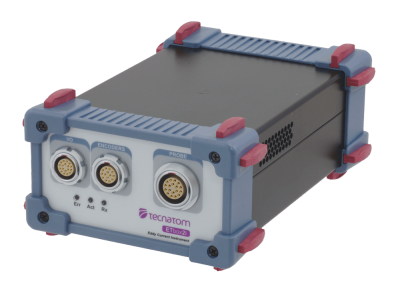
- Capacidad multicanal y multifrecuencia. Hasta 128 canales.
- Configurable con diferentes sondas: bobina, RFT, sonda de superficie o sondas multibobina/array con opciones de multiplexor.
Modos de inyección multiplexada y simultánea.
Amplia gama de frecuencias de 10 Hz a 5 MHz. Control de ganancia de canal independiente. Nulo de hardware y simulación de sonda de referencia.
Procesamiento de señales 100% digital a bordo. Filtros FIR y umbral de detección de señales.
Bajo consumo de energía. Placa única. Alta inmunidad al ruido EMC.
Controlador FPGA Ethernet 100/1000 integrado. Sin necesidad de PC integrados.
Fácil de transportar. Peso reducido.
Totalmente compatible con el software TEDDY que funciona bajo Windows.Software avanzado de adquisición y análisis para la inspección de tubos y superficies.
Visualización de datos en tiempo real: Strip-chart, Lissajous, C-Scan y 3Dviews.
Pantallas definibles por el usuario.
Configuración y calibración del instrumento. Filtros digitales.
Integración con sistemas mecánicos.
Software Teddy
El software Teddy incluye un conjunto completo de aplicaciones para la adquisición y el análisis avanzados tanto para la inspección de tubos como para otros componentes de la industria. El software TEDDY es compatible con Windows XP/7. Como alternativa, se dispone de software de controladores y documentación de apoyo para aplicaciones de usuario personalizables con los instrumentosETbox.
- Especificaciones técnicas -
GENERAL
EMISORES
Número
2
Tensión
0 – 24Vpp, paso de 1V
Modos
Inyección multiplexada y simultánea
Gama de frecuencias
De 10 Hz a 5 MHz.
RECEPTOR
Número
2
Ancho de banda
De 10 Hz a 5 MHz.
Rango de ganancia
0 a 40 dB, pasos de 1 dB (Ganancia analógica)
Algoritmos
Hardware Null
Simulación de bobina de referencia
FUNCIONES DIGITALES
Frecuencia de muestreo A/D
40 MSPS, 14 bits (procesamiento interno @16 bits)
Tasa de adquisición
Hasta 50000 acq/segundo
Sincronismo
Reloj interno, entrada digital externa, codificador
Filtros de frecuencia
Tipo FIR digital programable,
Reconocimiento de defectos en tiempo real
Detección de umbral
Detección tubo-aire
OTROS
Conector ET
Lemo ECG.3B.318.CLN
E/S digitales
4 entradas, 4 salidas Aislado (TTL/Diferencial)
E/S analógicas
2 entradas aisladas, 2 salidas aisladas. Ancho de banda ±10V 20KHz
Codificador
6 encoders Aislados. TTL / Diferencial.
Tipo incremental o de impulsos.
Puerto Ethernet
100/1000 BaseT
Dimensiones
183 x 115 x 64 mm (AnxPrxAl).
Potencia
100-240 Vca, 50-60Hz (20W)
ETbox2iR: 24 Vcc, 1 A máx.
ETbox8i
ETbox8i es un instrumento digital de corrientes de Foucault multicanal y multifrecuencia para la inspección de componentes en los sectores de generación de electricidad, nuclear e industrial. Admite sondas de corrientes de Foucault (ET) estándar y de campo remoto (RFT) y matrices de exploración de superficies. Software TEDDY disponible para adquisición y análisis.

- Capacidad multicanal y multifrecuencia. Hasta 512 canales.
- Configurable con diferentes sondas: bobina, MRPC, multibobina y matriz para inspección de tubos y superficies basada en sondas multibobina o matriz. Opciones de multiplexor.
- Modos de inyección multiplexada y simultánea.
- Amplia gama de frecuencias de 10 Hz a 5 MHz. Control independiente de la ganancia de canal. Simulación de sonda de referencia y nulo por hardware.
- Procesamiento de señales 100% digital a bordo. Filtros FIR y umbral de detección de señales.
- No necesita ventiladores y consume poca energía.
- Alta inmunidad contra ruidos CEM. Placa única. Sin cables.
- Controlador FPGA Ethernet 100/1000 integrado. Sin necesidad de PC integrados.
- Fácil de transportar. Peso reducido.
- Totalmente compatible con el software TEDDY que funciona bajo Windows.Software avanzado de adquisición y análisis para la inspección de tubos y superficies.
- Visualización de datos en tiempo real: Strip-chart, Lissajous, C-Scan y 3Dviews.
- Pantallas definibles por el usuario.
- Configuración y calibración del instrumento. Filtros digitales.
- Integración con sistemas mecánicos.
Software Teddy
El software Teddy incluye un conjunto completo de aplicaciones para la adquisición y el análisis avanzados tanto para la inspección de tubos como para otros componentes de la industria. El software TEDDY es compatible con Windows XP/7. También se dispone de software de controladores y documentación de apoyo para aplicaciones de usuario personalizables con los instrumentosETbox.
- Especificaciones técnicas -
GENERAL
16 franjas horarias hasta 64 frecuencias
Modo multiplexado: 128
Modo simultáneo: 32
Modo mixto: 512
ECT (corrientes de Foucault), ECA (matriz), RFT (campo remoto)
EMISORES
Número
4
Tensión
0 – 24Vpp, paso de 1V
Modos
Inyección multiplexada y simultánea
Gama de frecuencias
De 10 Hz a 5 MHz.
RECEPTOR
Número
8
Ancho de banda
De 10 Hz a 5 MHz.
Rango de ganancia
0 a 40 dB, pasos de 1 dB (Ganancia analógica)
Algoritmos
Hardware Null
Simulación de bobina de referencia
FUNCIONES DIGITALES
Frecuencia de muestreo A/D
40 MSPS, 14 bits (procesamiento interno @16 bits)
Tasa de adquisición
Hasta 50000 acq/segundo
Sincronismo
Reloj interno, entrada digital externa, codificador
Filtros de frecuencia
Tipo FIR digital programable,
Reconocimiento de defectos en tiempo real
Detección de umbral
Detección tubo-aire
OTROS
Conector ET
Amphenol MS3470L20-41S
E/S digitales
4 entradas, 4 salidas Aislado (TTL/Diferencial)
E/S analógicas
2 entradas aisladas, 2 salidas aisladas. Ancho de banda ±10V 20KHz
Codificador
6 encoders Aislados. TTL / Diferencial.
Tipo incremental o de impulsos.
Puerto Ethernet
100/1000 BaseT
Dimensiones
250 x 300 x 270 mm (AnxPrxAl).
Potencia
100-240 Vca, 50-60 Hz (100 W)
ETboxMB
ETbox MB es un instrumento portátil de corrientes de Foucault con capacidad multicanal y multifrecuencia para la detección de defectos, conductividad y medición de espesores.
ETboxMB está disponible en varios modelos conectables a Tablet con windows por wifi o USB para satisfacer la más amplia gama de necesidades de inspección.
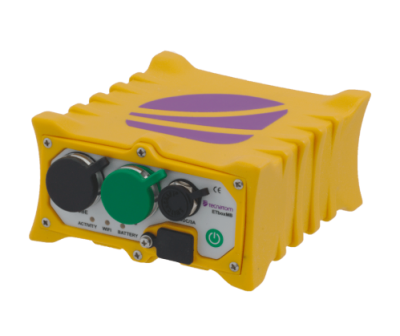
- Hasta 4 canales en tiempo real.
- Gama de frecuencias de 10 Hz a 10 MHz.
- Sondas compatibles: EC estándar, conductividad, escáner giratorio, ECA.
- Equilibrado interno automático (hardware nulo).
- Filtros mejorados para el modo de escáner giratorio.
- Sonda y conector de E/S.
- Conexión WiFi o USB.
- Pantalla SW en funcionamiento en Tablet o portátil.
- Interfaz de usuario muy intuitiva (varios idiomas).
- Opción de pantalla completa en cualquier modo de visualización. (Lissajous, Stripchart, Stripchart-Lissajous, Cascada, Cscan y Vista 3D).
- Generación de informes con un solo clic (fotos y capturas de pantalla).
- Informes personalizables con plantillas.
- Ligero: menos de 1 kg (batería incluida).
- Batería de larga duración (hasta 10 horas).
Software Teddy
El software Teddy incluye un conjunto completo de aplicaciones para la adquisición y el análisis avanzados tanto para la inspección de tuberías como para otros componentes de la industria.
El software TEDDY es compatible con Windows XP/7. Como alternativa, se dispone de software de controladores y documentación de apoyo para aplicaciones de usuario personalizables con los instrumentosETbox.
- Especificaciones técnicas -
GENERAL
4 franjas horarias hasta 4 frecuencias Modo multiplexado: 4 Modo simultáneo: 4
ECT (corrientes de Foucault), ECA (matriz), Conductividad y espesor, Bolthole giratorio
Duración de la batería
Hasta 10 horas
Portabilidad
Tableta u ordenador portátil con interfaz de usuario ultrafácil Software disponible.
EMISORES
Número
1
Tensión
0 – 16Vpp, paso de 1V
Modos
Inyección multiplexada y simultánea
Gama de frecuencias
De 10 Hz a 5 MHz.
RECEPTOR
Número
1
Ancho de banda
De 10 Hz a 5 MHz.
Rango de ganancia
0 a 90 dB, pasos de 0,1 dB, componente H
0 a 90 dB, pasos de 0,1 dB, componente V
Algoritmos
Hardware Nulo
FUNCIONES DIGITALES
Frecuencia de muestreo A/D
40 MSPS, 16 bits
Tasa de adquisición
Hasta 10000 acq/segundo
Sincronismo
Reloj interno, entrada digital externa, codificador
Filtros de frecuencia
Tipo FIR digital programable, paso alto, paso banda y paso bajo
Reconocimiento de defectos en tiempo real
Rectangular, Circular, Polar, Umbral.
Reconocimiento de sondas
Reconocimiento automático de sondas y configuraciones
Informes
Generación de informes con un solo clic (fotos y capturas de pantalla).
OTROS
Conector ET
Lemo EEG.2K.318.CLN
E/S digitales
4 entradas, 4 salidas Aislado (TTL/Diferencial)
E/S analógicas
2 entradas aisladas, 2 salidas aisladas. Ancho de banda ±10V 20KHz
Codificador
2 encoders Aislados. TTL / Diferencial. Tipo incremental o de impulsos.
Puerto Ethernet
Wifi 802.11 b,g y USB 2.0
Dimensiones
112 x 131 x 59 mm (AnxPrxAl).
Potencia
Batería interna o fuente de alimentación externa
Sonia Blanco
Sonia White es un módulo ultrasónico phased-array compatible con la arquitectura SONIA. Este módulo dispone de 32×128 canales UT (multiplexados) con altas prestaciones en electrónica analógica y en procesamiento digital de señales.
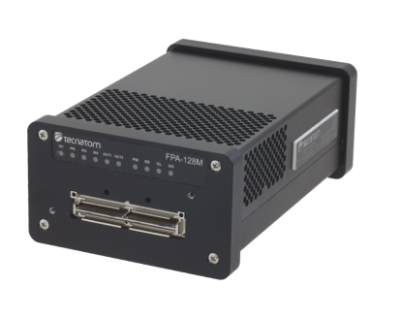
- 32×128 canales UT, multiplexados (32 receptores, 128 emisores de impulsos).
- TX/RX separadas para aplicaciones de pulso-eco, transmisión pasante y tándem.
- Aperturas de 1 a 32 elementos.
- Ancho de banda de 0,45 a 28MHz (sondas de 0,5 a 20MHz).
- Pulsador de onda cuadrada negativa, hasta -100 V.
- Alta capacidad de procesamiento digital de señales (DDF, filtros digitales, compuertas, tipos de señal, etc…).
- Tamaño reducido que permite minimizar la longitud de los cables de los transductores, digitalizando la señal UT muy cerca de los transductores. Esto implica una menor distorsión, atenuación y ruido de la señal UT.
- Sustituye las líneas de comunicación analógicas por otras digitales, inmunes a las interferencias electromagnéticas (fibra óptica), lo que se traduce en ausencia de distorsión de la señal y/o ruido en las señales transmitidas y un rendimiento independiente de la disposición de la instalación.
- Bajo consumo de energía. Caja robusta, grado de protección IP54.
- Tamaño reducido que permite minimizar la longitud de los cables de los transductores, digitalizando la señal UT muy cerca de los transductores. Esto implica una menor distorsión, atenuación y ruido de la señal UT.
- Sustituye las líneas de comunicación analógicas por otras digitales, inmunes a las interferencias electromagnéticas (fibra óptica), lo que se traduce en ausencia de distorsión de la señal y/o ruido en las señales transmitidas y un rendimiento independiente de la disposición de la instalación.
- Bajo consumo de energía. Caja robusta , grado de protección IP54
- Especificaciones técnicas -
GENERAL
Electrónica
Electrónica
Canales UT
32×128 canales multiplexados (TX/RX separados)
Técnicas UT
Pulso-eco, transmisión pasante, tándem
PULSER
Tipo
Onda cuadrada negativa
Tensión
De -15 a -100 V, pasos de 1 V
Anchura
20 a 1000 ns, pasos de 2,0 ns
Máximo PRF
20 KHz
Tiempo de otoño
<6 ns
Impedancia
<15 Ω
RECEPTOR
Rango de entrada
0,8 Vpp
Ancho de banda
0,45 a 28MHz @-3dB
Rango de ganancia
0 a 80 dB, pasos de 0,1 dB (ganancia analógica) 0 a 40 dB, pasos de 0,1 dB (ganancia digital)
TGC
Alcance máximo de 60 dB, 16 puntos, extensión de 16 ms, resolución de 32 ns, pendiente de 40 dB/us
VIGA ANTIGUA
Leyes focales
Hasta 4096, 128 escaneos.
Tipos de escaneado electrónico
Lineal, sectorial, complejo
Enfoque
Enfoque dinámico de profundidad (DDF)
FUNCIONES DIGITALES
Frecuencia de muestreo A/D
125 MSPS, 12 bits (procesamiento interno @18 bits) Factor de decimación de muestreo: de 1 a 16
Puertas
4 puertas, máx. + 8 primeros ecos por puerta. 1 puerta para sincronización de eco de interfaz
Modos de señal
RF, Envolvente real, Rectificado (completo, +/-), Logarítmico (digital)
Filtros de frecuencia
Tipo IIR digital programable, paso bajo, paso alto, paso banda.
Filtros de reducción de ruido
Promedio
Ruido antiimpulsivo
Filtro de suavizado post-rect
Control del nivel de suavizado de 0 a 100%
Otras funciones digitales
Alarmas en tiempo real asociadas a ecos en puertas.
Inversión de señal.
Factor de compresión de señal hasta 64.
OTROS
Conectores UT
Minidock I-PEX
E/S generales
4 entradas digitales, 2 salidas digitales (hasta 24 V) optoacopladas
Puerto de fibra óptica
Conector óptico dúplex LC (1 Gbit dúplex completo)
Dimensiones
166x 111x 64 mm (AnxPrxAl).
Potencia
24 Vcc, 25 W típ.
Accesorios
Conversor de conectores IPEX a Hypertronics Divisor IPEX (2×64 canales) para aplicaciones de sonda doble
Sonia Blanco S
Sonia White S es un módulo ultrasónico phased-array de altas prestaciones compatible con la arquitectura SONIA. Este módulo dispone de 64×128 canales UT (multiplexados) con las máximas prestaciones en electrónica analógica y en procesamiento digital de señales.
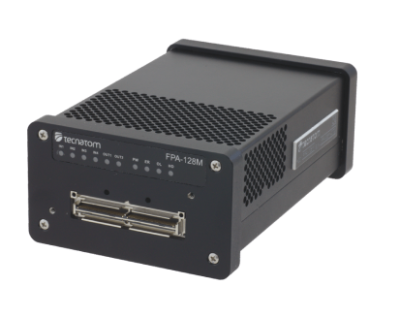
- 64×128 canales (los canales de emisión pueden ser diferentes de los canales de recepción, incluso utilizando la apertura máxima de 64 canales).
- 4 formadores de haces paralelos para emisiones y 4 cadenas de formadores de haces paralelos para recepción de hasta 32 elementos.
- Ancho de banda @-3dB de 0,3 a 20MHz.
- Pulsador de onda cuadrada negativa, hasta -100 V.
- Altas capacidades de procesamiento digital de señales (DDF, filtros digitales, compuertas, tipos de señales, etc…). Múltiples capacidades DSP por ley focal paralela (filtros, compresión de datos, …).
- Tamaño reducido que permite minimizar la longitud de los cables de los transductores, digitalizando la señal UT muy cerca de los transductores. Esto implica una menor distorsión, atenuación y ruido de la señal UT.
- Sustituye las líneas de comunicación analógicas por otras digitales, inmunes a las interferencias electromagnéticas (fibra óptica), lo que se traduce en ausencia de distorsión de la señal y/o ruido en las señales transmitidas y un rendimiento independiente de la disposición de la instalación.
- Bajo consumo de energía. Caja robusta, grado de protección IP54.
- Especificaciones técnicas -
GENERAL
Electrónica
Compatible con la arquitectura SONIA
Canales UT
64×128 canales multiplexados (TX/RX separados)
Técnicas UT
Pulso-eco, transmisión pasante, tándem
PULSER
Tipo
Onda cuadrada negativa
Tensión
De -15 a -100 V, pasos de 1 V
Anchura
20 a 1000 ns, pasos de 2,0 ns
Máximo PRF
15 KHz
Tiempo de otoño
<6 ns
Impedancia
<15 Ω
RECEPTOR
Rango de entrada
Hasta 3,8 Vpp
Ancho de banda
0,26 a 20,7 MHz @-3dB
Rango de ganancia
0 a 40 dB, pasos de 0,1 dB (ganancia analógica) 0 a 40 dB, pasos de 0,1 dB (ganancia digital)
TGC
Analógico y digital, rango máximo de 40 dB, 20 puntos, extensión de 16 ms, resolución de 32 ns, pendiente de 40 dB/us
VIGA ANTIGUA
Leyes focales
Hasta 4096, 128 escaneos.
Tipos de escaneado electrónico
Lineal, sectorial, complejo
Enfoque
Enfoque dinámico de profundidad (DDF)
FUNCIONES DIGITALES
Procesamiento paralelo
Hasta 4 leyes focales
Frecuencia de muestreo A/D
125 MSPS, 12 bits (procesamiento interno @18 bits) Factor de decimación de muestreo: de 1 a 16
Puertas
4 puertas, máx. + 8 primeros ecos por puerta. 1 puerta para sincronización de eco de interfaz
Modos de señal
RF, Envolvente real, Rectificado (completo, +/-), Logarítmico (digital)
Filtros de frecuencia
Tipo IIR digital programable, paso bajo, paso alto, paso banda.
Filtros de reducción de ruido
Promedio
Ruido antiimpulsivo
Filtro de suavizado post-rect
Control del nivel de suavizado de 0 a 100%
Otras funciones digitales
Alarmas en tiempo real asociadas a ecos en las puertas.
Inversión de la señal.
Compresión de la señal
Factor hasta 64
OTROS
Conectores UT
Minidock I-PEX
E/S generales
4 entradas digitales, 2 salidas digitales (hasta 24 V) optoacopladas, salida de sincronización
Puerto de fibra óptica
Conector óptico dúplex LC (1 Gbit dúplex completo)
Dimensiones
166x 111x 64 mm (AnxPrxAl).
Potencia
24 Vcc, 25 W típ.
Accesorios
Conversor de conectores IPEX a Hypertronics Divisor IPEX (2×64 canales) para aplicaciones de sonda doble
Sonia Green
Sonia Green es un módulo ultrasónico dual compatible con la arquitectura SONIA diseñado para aplicaciones de transmisión directa (TTU). Este módulo se divide en dos submódulos, 2 canales completos, con pulsador de alta potencia (FTT-2T) y receptor de alto rango dinámico (FTT-2R)
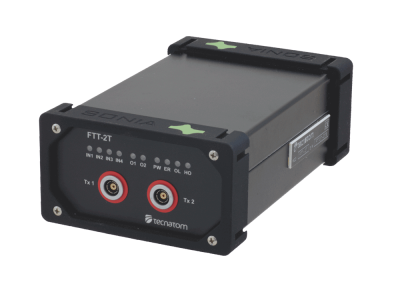
- A través de -Transmisión, tándem, pitch & catch, pulso-eco (doble sonda) aplicaciones .
- Sondas acopladas por contacto, agua o aire
- Etapa receptora totalmente digital, con alto rango dinámico (>105 dB sin filtros, >130 dB con filtros).
- Gama de baja y media frecuencia, ancho de banda de 20 KHz a 20 MHz (sondas de 50KHz a 10 MHz).
- Pulsador de onda cuadrada negativa, bipolar y de ráfaga, hasta 400 Vpp, 16 ciclos..
- Alta capacidad de procesamiento digital de señales (filtros digitales, compuertas, tipos de señal, etc.).
- Tamaño reducido que permite minimizar la longitud de los cables de los transductores, digitalizando la señal UT muy cerca de los transductores. Esto implica una menor distorsión, atenuación y ruido de la señal UT.
- Sustituye las líneas de comunicación analógicas por otras digitales, inmunes a las interferencias electromagnéticas (fibra óptica), lo que se traduce en ausencia de distorsión de la señal y/o ruido en las señales transmitidas y un rendimiento independiente de la disposición de la instalación.
- Bajo consumo de energía. Las placas electrónicas están selladas en una caja robusta no ventilada.
- Especificaciones técnicas -
GENERAL
Tipo
Onda cuadrada bipolar
Tensión
20 a 400 V, pasos de 1 V.
Anchura
50 a 10000 ns, pasos de 1,0 ns
PRF máxima
10 KHz
Tiempo de otoño
<15 ns
Impedancia
< 5 Ω
Amortiguación interna
470 Ω
PULSER
Tipo
Onda cuadrada bipolar
Tensión
20 a 400 V, pasos de 1 V.
Anchura
100 a 20000 ns, pasos de 5,0 ns
Ráfaga
1-16 Ciclos
RECEPTOR
Rango de entrada
30 Vpp
Ancho de banda
Bajo 22,5KHz a 20,5 MHz @-3dB Medio Bajo 26,5KHz a 20,5MHz @-3dB Medio Alto 108KHz a 20,5MHz @-3dB Alto 390KHz a 20,5MHz @-3dB
Rango de ganancia
0 a 140 dB, pasos de 0,1 dB
TGC
Alcance máximo de 80 dB, 16 puntos, 16 ms, resolución de 32 ns, pendiente de 80 dB/us.
Rango dinámico
116 dB
FUNCIONES DIGITALES
Frecuencia de muestreo A/D
125 MSPS, 14 bits
Factor de decimación de muestreo: de 1 a 64
Puertas
4 puertas, máx. + 4 primeros ecos por puerta.
1 puerta para sincronización de ecos de interfaz.
Modos de señal
RF, envolvente real, rectificado (completo, +/-).
Onda completa logarítmica, Envolvente logarítmica
Filtros de frecuencia
Tipo IIR digital programable, paso bajo, paso alto, paso banda.
Filtros de reducción de ruido
Promedio
Ruido antiimpulsivo
Filtro de suavizado post-rect
Control del nivel de suavizado de 0 a 100%
Otras funciones digitales
Alarmas en tiempo real asociadas a ecos en puertas.
Inversión de señal.
Factor de compresión de señal hasta 64.
OTROS
Conectores UT
FISCHER D103A015
E/S generales
4 entradas digitales, 2 salidas digitales (hasta 24 V) optoacopladas.
Puerto de fibra óptica
Conector óptico dúplex LC (1 Gbit dúplex completo)
Dimensiones
FTT-2T: 175 x 115 x 64 mm (AnxAlxAl). FTT-2R: 175 x 115 x 64 mm (AnxAlxAl).
Potencia
FTT-2T: 24 Vcc, 1,2 A máx.
FTT-2R: 24 Vcc, 0,6 A máx.
Accesorios
Adaptador FTT-2 PE: P/E Technique GENIUS PUA-UT: Preamplificador de alta sensibilidad 58dB de ganancia
Sonia Violeta
Sonia Violet es un módulo de ultrasonidos compatible con la arquitectura SONIA diseñado para accionar sondas de alta frecuencia. Este módulo dispone de 1 canal UT con gran ancho de banda, destinado a aplicaciones en el campo de la inspección de componentes finos, microscopía ultrasónica, caracterización de materiales, etc….
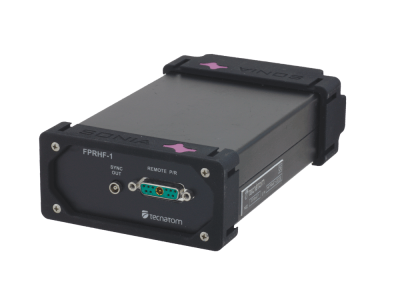
- Canal UT, sonda monocristalina.
- Técnica de pulso-eco.
- Ancho de banda de 4 a 200 MHz (sondas de 10 a 150 MHz).
- Pulsador de pico negativo de alta velocidad con dos niveles de energía (bajo y alto).
- Alta capacidad de procesamiento digital de señales (filtros, compuertas, tipos de señal, etc.).
- 2 unidades electrónicas diferentes: unidad principal y pulsador-preamplificador remoto, capaces de funcionar bajo el agua. La longitud máxima del cable es de 3 metros.
- Tamaño reducido que permite minimizar la longitud de los cables de los transductores, digitalizando la señal UT muy cerca del transductor. Esto implica una menor distorsión, atenuación y ruido de la señal UT.
- Sustituye las líneas de comunicación analógicas por otras digitales, inmunes a las interferencias electromagnéticas (fibra óptica), lo que se traduce en ausencia de distorsión de la señal y/o ruido en las señales transmitidas y un rendimiento independiente de la disposición de la instalación.
- Bajo consumo de energía. Las placas electrónicas están selladas en una caja robusta no ventilada.
- Tamaño reducido que permite minimizar la longitud de los cables de los transductores, digitalizando la señal UT muy cerca del transductor. Esto implica una menor distorsión, atenuación y ruido de la señal UT.
- Sustituye las líneas de comunicación analógicas por otras digitales, inmunes a las interferencias electromagnéticas (fibra óptica), lo que se traduce en ausencia de distorsión de la señal y/o ruido en las señales transmitidas y un rendimiento independiente de la disposición de la instalación.
- Bajo consumo de energía. Las placas electrónicas están selladas en una caja robusta no ventilada.
- Especificaciones técnicas -
GENERAL
Electrónica
Compatible con la arquitectura SONIA
Canales UT
1 canal de alta frecuencia, sonda monocristal
Técnicas UT
Pulso-eco (inmersión)
PULSER
Tipo
Pico negativo
Tensión
Dos niveles: -60 V (baja energía), -210 V (alta energía)
Anchura
7 ns ±2ns (LE) 10 ns<br> ±2ns (HE)
PRF máxima
10 KHz
Tiempo de otoño
5 ns ±2ns (LE), 4 ns ±2ns (HE)
Tiempo de subida
<3 ns (LE), 6 ns ±2ns (HE)
Impedancia
<25 Ω
RECEPTOR
Tipo de amplificador
Lineal
Rango de entrada
240 mVpp
Ancho de banda
4 a 200 MHz @-3dB
Rango de ganancia
0 a 80 dB, pasos de 0,1 dB
FUNCIONES DIGITALES
Frecuencia de muestreo A/D
2 GSPS, 8 bits
Factor de decimación de muestreo: de 1 a 16
Puertas
8 puertas, máx. + 8 primeros ecos por puerta.
1 puerta para sincronización de ecos de interfaz.
Modos de señal
RF, rectificado (completo, +/-)
Longitud A-scan
32 Kmuestras
Filtros de reducción de ruido
Promedio
Ruido antiimpulsivo
Filtro de suavizado post-rect
Control del nivel de suavizado de 0 a 100%
Otras funciones digitales
Alarmas en tiempo real asociadas a ecos en puertas.
Inversión de señal.
Factor de compresión de señal hasta 64.
OTROS
Conectores UT
16 conectores coaxiales LEMO 00
(8 conectores T/R + 8 conectores R)
(8 conectores T/R + 8 conectores R)
E/S generales
4 entradas digitales, 2 salidas digitales (hasta 24 V) optoacopladas.
Puerto de fibra óptica
Conector óptico dúplex LC (1 Gbit dúplex completo)
Dimensiones
Mando a distancia P/R: 50 x 50 x 32 mm (peso 150 g).
Unidad principal: 175 x 115 x 64 mm. mm (peso 950 g).
Potencia
24 Vcc, 1 A máx. (11 W típ.)
Sonia Azul
Sonia Blue es un módulo ultrasónico convencional compatible con la arquitectura SONIA. Este módulo dispone de 8 canales UT con altas prestaciones en electrónica analógica y en procesamiento digital de señales.
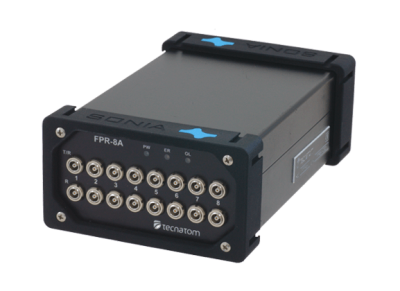
- 8 canales UT, sondas de cristal simple o doble.
- Aplicaciones convencionales (pulso-eco, transmisión pasante y técnicas TOFD).
- Amplificadores lineales y logarítmicos, con alto rango dinámico (>90 dB).
- Ancho de banda de 0,4 a 30 MHz (sondas de 0,5 a 20 MHz).
- Pulsador de onda cuadrada negativa, hasta -300 V.
- Alta capacidad de procesamiento digital de señales (filtros digitales, compuertas, tipos de señales, etc.)
- Tamaño reducido que permite minimizar la longitud de los cables de los transductores, digitalizando la señal UT muy cerca de los transductores. Esto implica una menor distorsión, atenuación y ruido de la señal UT.
- Sustituye las líneas de comunicación analógicas por otras digitales, inmunes a las interferencias electromagnéticas (fibra óptica), lo que se traduce en ausencia de distorsión de la señal y/o ruido en las señales transmitidas y un rendimiento independiente de la disposición de la instalación.
- Bajo consumo de energía. Las placas electrónicas están selladas en una caja robusta no ventilada.
- Especificaciones técnicas -
GENERAL
Tipo
Onda cuadrada negativa
Tensión
De -100 a -300 V, pasos de 5 V.
Anchura
40 a 500 ns, pasos de 1,0 ns
PRF máxima
20 KHz
Tiempo de otoño
<5 ns
Impedancia
< 10 Ω
Amortiguación interna
150 Ω
PULSER
Tipo
Onda cuadrada negativa
Tensión
De -20 a -300 V, pasos de 1 V.
Anchura
15 a 1000 ns, pasos de 1,0 ns
PRF máxima
20 KHz
Tiempo de otoño
<7 ns
Impedancia
<4 Ω
Amortiguación interna
470 Ω
RECEPTOR
Tipo de amplificador
Lineal y logarítmica
Rango de entrada
2,1 Vpp
Ancho de banda
0,4 a 30 MHz @-3dB
Rango de ganancia
0 a 120 dB, pasos de 0,1 dB (80 dB analógicos + 40 dB digitales)
Curva DAC
Alcance máximo de 80 dB, 16 puntos, 16 ms, resolución de 32 ns, pendiente de 40 dB/us.
Rango dinámico
90 dB (en modo logarítmico)
FUNCIONES DIGITALES
Frecuencia de muestreo A/D
125 MSPS, 14 bits
Factor de decimación de muestreo: de 1 a 16
Puertas
8 puertas, máx. + 8 primeros ecos por puerta.
1 puerta para sincronización de ecos de interfaz.
Modos de señal
RF, Envolvente real, Rectificado (completo, +/-), Logarítmico (analógico), Logarítmico (digital)
Filtros de frecuencia
Tipo IIR digital programable, paso bajo, paso alto, paso banda.
Filtros de reducción de ruido
Promedio
Ruido antiimpulsivo
Filtro de suavizado post-rect
Control del nivel de suavizado de 0 a 100%
Otras funciones digitales
Alarmas en tiempo real asociadas a ecos en puertas. Inversión de señal. Factor de compresión de señal hasta 64.
OTROS
Conectores UT
16 conectores coaxiales LEMO 00
(8 conectores T/R + 8 conectores R)
E/S generales
4 entradas digitales, 2 salidas digitales (hasta 24 V) optoacopladas.
Puerto de fibra óptica
Conector óptico dúplex LC (1 Gbit dúplex completo)
Dimensiones
175 x 115 x 64 mm (AnxPrxAl).
Potencia
24 Vcc, 0,5 A máx.